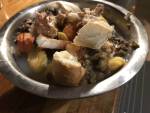Postauksessa Ruokinnan GI-voimat sivuttiin insuliinia ja hiilihydraatteja, ja kerrottiin – kevyesti – eri hiilihydraattilähteistä. Täysin samaa asiaa sivuaa seuraava tutkimus, jossa testattiin kuuden eri hiilihydraattilähteen sulavuutta ja miten ne vaikuttavat insuliinipiikkiin. Lopputulos ei ollut mitenkään yllättävä eikä uusi, mutta se kannattaa ottaa esille vaikka sitten vain ihan kertauksen vuoksi. Koirilla on lisääntyvää ongelma insuliiniresistenssin kanssa, ja monet omistajat pyrkivät ihan yleisenkin terveyden takia vähentämään koiriensa sinänsä turhaa hiilihydraattien saanti. Paras, tehokkain, pahin (tarpeettomat yliviivataan) oli panimoriisi ja hyvänä kakkosena maissi. Tarvitseeko muistuttaa mitkä viljat ovat eniten käytettyjä kuivamuonissa?
A. C. Carciofi,, F. S. Takakura, L. D. De-Oliveira, E. Teshima, J. T. Jeremias, M. A. Brunetto, F. Prada
Effects of six carbohydrate sources on dog diet digestibility and post-prandial glucose and insulin response
Journal of Animal Physiology and Animal Nutrition Volume 92, Issue 3, pages 326–336, June 2008
The effects of six extruded diets with different starch sources (cassava flour, brewer’s rice, corn, sorghum, peas or lentils) on dog total tract apparent digestibility and glycemic and insulinemic response were investigated. The experiment was carried out on thirty-six dogs with six dogs per diet in a completely randomized design. The diets containing brewer’s rice and cassava flour presented the greatest digestibility of dry matter, organic matter and gross energy (p < 0.05), followed by corn and sorghum; pea and lentil diets had the lowest. Starch digestibility was greater than 98% in all diets and was greater for brewer’s rice and cassava flour than for lentils and peas diets (p < 0.05). Dogs’ immediate post-prandial glucose and insulin responses (AUC ≤ 30 min) were greater for brewer’s rice, corn, and cassava flour diets (p < 0.05), and later meal responses (AUC ≥ 30 min) were greater for sorghum, lentil and pea diets (p < 0.05). Variations in diet digestibility and post-prandial response can be explained by differences in chemical composition of each starch source including fibre content and starch granule structure. The nutritional particularities of each starch ingredient can be explored through diet formulations designed to modulate glycemic response. However, more studies are required to support these.



